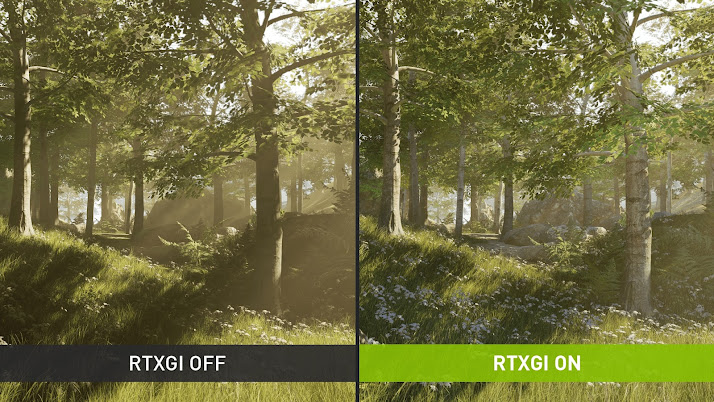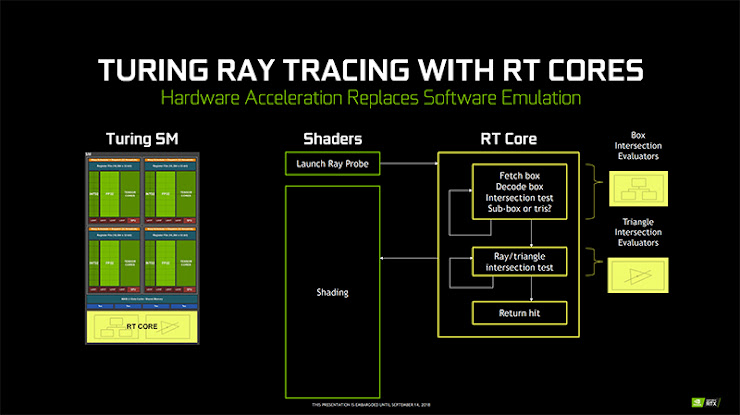In 3D computer graphics, ray tracing is a technique for modeling light transport for use in a wide variety of rendering algorithms for generating digital images.
On a spectrum of computational cost and visual fidelity, ray tracing-based rendering techniques, such as ray casting, recursive ray tracing, distribution ray tracing, photon mapping and path tracing, are generally slower and higher fidelity than scanline rendering methods. Thus, ray tracing was first deployed in applications where taking a relatively long time to render could be tolerated, such as in still computer-generated images, and film and television visual effects (VFX), but was less suited to real-time applications such as video games, where speed is critical in rendering each frame.
Since 2018, however, hardware acceleration for real-time ray tracing has become standard on new commercial graphics cards, and graphics APIs have followed suit, allowing developers to use hybrid ray tracing and rasterization-based rendering in games and other real-time applications with a lesser hit to frame render times.
Ray tracing is capable of simulating a variety of optical effects, such as reflection, refraction, soft shadows, scattering, depth of field, motion blur, caustics, ambient occlusion and dispersion phenomena (such as chromatic aberration). It can also be used to trace the path of sound waves in a similar fashion to light waves, making it a viable option for more immersive sound design in video games by rendering realistic reverberation and echoes.[4] In fact, any physical wave or particle phenomenon with approximately linear motion can be simulated with ray tracing.
Highlighted
RTX Global Illumination
Multi-bounce indirect light without bake times, light leaks, or expensive per-frame costs. RTX Global Illumination (RTXGI) is a scalable solution that powers infinite bounce lighting in real time, even with strict frame budgets. Accelerate content creation to the speed of light with real-time in-engine lighting updates, and enjoy broad hardware support on all DirectX Raytracing (DXR)-enabled GPUs. RTXGI was built to be paired with RTX Direct Illumination (RTXDI) to create fully ray-traced scenes with an unrestrained count of dynamic light sources.

RTX Direct Illumination
Millions of dynamic lights, all fully ray traced, can be generated with RTX Direct Illumination. A real-time ray-tracing SDK, RTXDI offers photorealistic lighting of night and indoor scenes that require computing shadows from 100,000s to millions of area lights. No more baking, no more hero lights. Unlock unrestrained creativity even with limited ray-per-pixel counts. When integrated with RTXGI and NVIDIA Real-Time Denoiser (NRD), scenes benefit from breathtaking and scalable ray-traced illumination and crisp denoised images, regardless of whether the environment is indoor or outdoor, in the day or night.
Deep Learning Super Sampling
AI-powered frame rate boost delivers best-in-class image quality. NVIDIA Deep Learning Super Sampling (DLSS) leverages the power of Tensor Cores on RTX GPUs to upscale and sharpen lower-resolution input to a higher-resolution output using a generalized deep learning network trained on NVIDIA supercomputers. The result is unmatched performance and the headroom to maximize resolution and ray-tracing settings.
RT Cores And Tensor Cores
RT Cores
RT Cores are accelerator units that are dedicated to performing ray-tracing operations with extraordinary efficiency. Combined with NVIDIA RTX software, RT Cores enable artists to use ray-traced rendering to create photorealistic objects and environments with physically accurate lighting.
Tensor Cores
Tensor Cores enable AI on NVIDIA hardware. They’re leveraged for upscaling and sharpening with DLSS, delivering a performance boost and image quality that would be unattainable without deep learning-powered super sampling.
Ray casting algorithm
The idea behind ray casting, the predecessor to recursive ray tracing, is to trace rays from the eye, one per pixel, and find the closest object blocking the path of that ray. Think of an image as a screen-door, with each square in the screen being a pixel. This is then the object the eye sees through that pixel. Using the material properties and the effect of the lights in the scene, this algorithm can determine the shading of this object. The simplifying assumption is made that if a surface faces a light, the light will reach that surface and not be blocked or in shadow. The shading of the surface is computed using traditional 3D computer graphics shading models. One important advantage ray casting offered over older scanline algorithms was its ability to easily deal with non-planar surfaces and solids, such as cones and spheres. If a mathematical surface can be intersected by a ray, it can be rendered using ray casting. Elaborate objects can be created by using solid modeling techniques and easily rendered.
Advantages And Disadvantages
Advantages
Ray tracing-based rendering's popularity stems from its basis in a realistic simulation of light transport, as compared to other rendering methods, such as rasterization, which focuses more on the realistic simulation of geometry. Effects such as reflections and shadows, which are difficult to simulate using other algorithms, are a natural result of the ray tracing algorithm. The computational independence of each ray makes ray tracing amenable to a basic level of parallelization, but the divergence of ray paths makes high utilization under parallelism quite difficult to achieve in practice.
Disadvantages
A serious disadvantage of ray tracing is performance (though it can in theory be faster than traditional scanline rendering depending on scene complexity vs. number of pixels on-screen). Until the late 2010s, ray tracing in real time was usually considered impossible on consumer hardware for nontrivial tasks. Scanline algorithms and other algorithms use data coherence to share computations between pixels, while ray tracing normally starts the process anew, treating each eye ray separately. However, this separation offers other advantages, such as the ability to shoot more rays as needed to perform spatial anti-aliasing and improve image quality where needed.
Although it does handle interreflection and optical effects such as refraction accurately, traditional ray tracing is also not necessarily photorealistic. True photorealism occurs when the rendering equation is closely approximated or fully implemented. Implementing the rendering equation gives true photorealism, as the equation describes every physical effect of light flow. However, this is usually infeasible given the computing resources required.
The realism of all rendering methods can be evaluated as an approximation to the equation. Ray tracing, if it is limited to Whitted's algorithm, is not necessarily the most realistic. Methods that trace rays, but include additional techniques (photon mapping, path tracing), give a far more accurate simulation of real-world lighting.







No comments:
Post a Comment